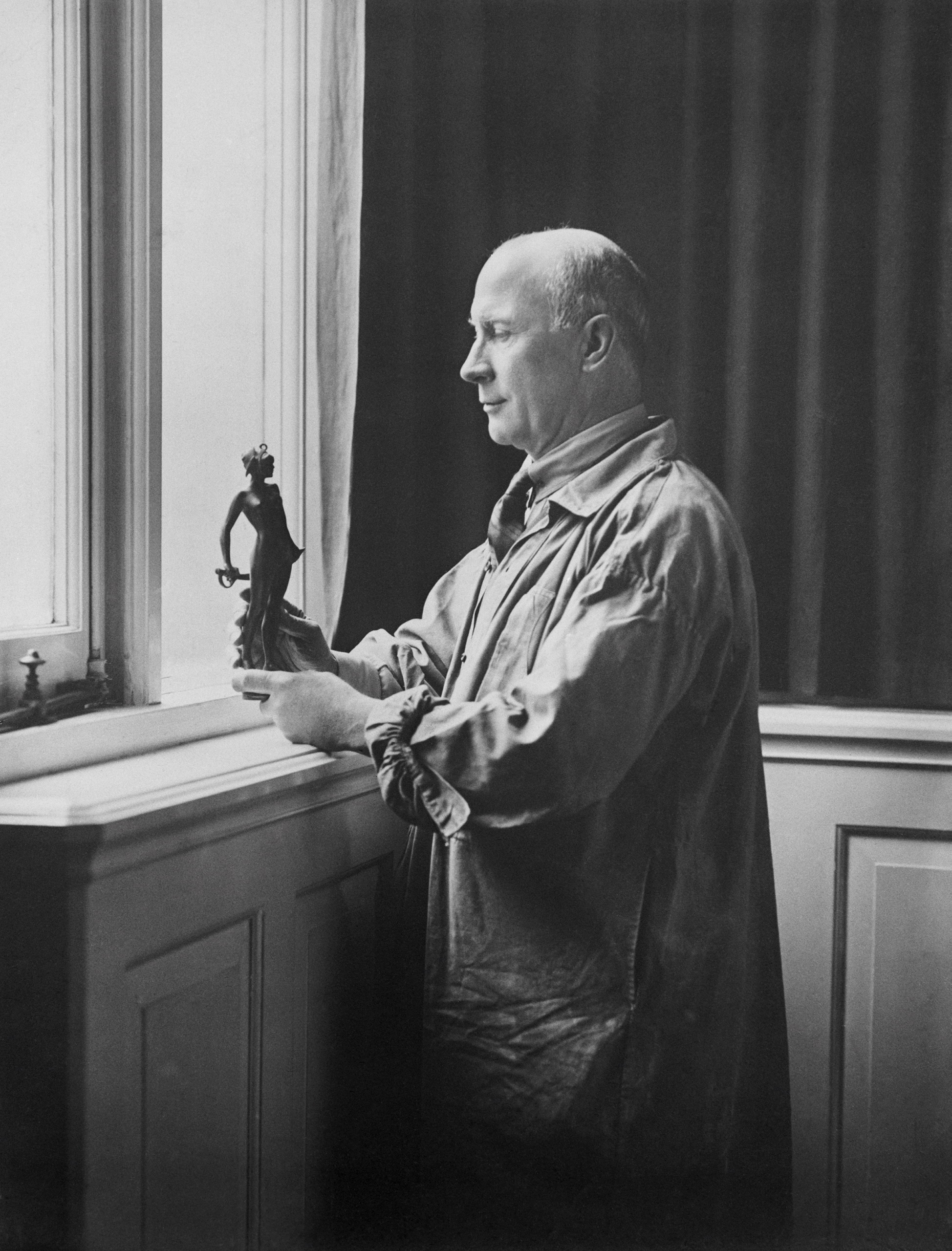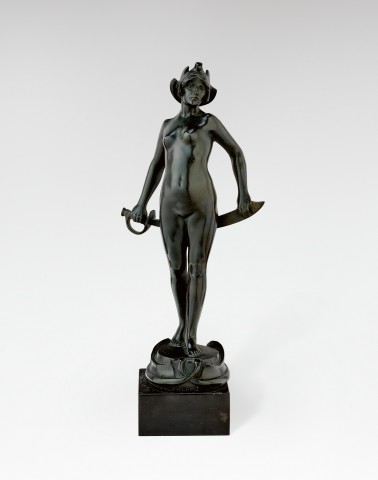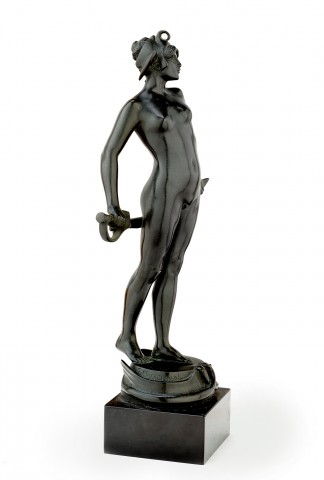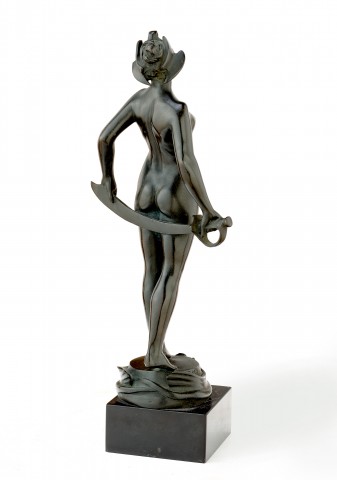SALOME, 1897
BERTRAM MACKENNAL
bronze
29.0 cm height
32.5 cm (inc. base)
signed at base: B. MACKENNAL
inscribed with title at base: SALOME
original black marble base
Macquarie Galleries, Sydney
Dr Jean Campbell, Sydney and Canberra
McClelland Collection, McClelland Sculpture Park and Gallery, Langwarrin, acquired from the above on 24 June 1992
Summer Exhibition, Royal Academy of Arts, London, UK, May 1897, cat. 2053 (another example)
Bertram Mackennal sculpture from the Stawell Gallery, National Gallery of Victoria, Melbourne, February 1901 (another example)
First Exhibition of Statuettes by the Sculptors of To-day, British and French, Fine Art Society, London, UK, 1902, cat. 37 (another example)
Exhibition of bronzes by Sir Bertram Mackennal K.C.V.O., R.A., Macquarie Galleries, Sydney, 7 – 20 October 1926, cat. 18 (another example)
Exhibition of Bronzes by Sir Bertram Mackennal K.C.V.O., R.A., Fine Art Society’s Gallery, Melbourne, 16 – 29 May 1928, cat. 7 (another example)
Memorial exhibition of statuettes by the Late Sir Bertram Mackennal, K.C.V.O, Fine Art Society’s Gallery, Melbourne, May 1932, cat. 21 (another example)
Commemorative Exhibition of Works by Late Members, Winter Exhibition, Royal Academy of Arts, London, UK, 7 January – 11 March 1933, cat. 586 (another example)
British Sculpture 1850 – 1914, Fine Art Society, London, UK, 30 September – 30 October 1968, cat. 108 (another example)
S.H. Ervin Memorial Exhibition, S.H. Ervin Gallery, Sydney, 18 May – 17 December 1979, cat. 34 (illus. in exhibition catalogue p. 2, another example)
Treasures of the National Trust, S.H. Ervin Gallery, Sydney, 5 March – 26 April 1982, cat. 89 (another example)
Renaissance References in Australian Art, University Gallery, University of Melbourne, Victoria, 14 August – 20 September 1985, cat. 9 (illus. in exhibition catalogue p. 9, another example)
Australian Sculpture 1890 – 1919, Art Gallery of New South Wales, Sydney, 22 January – 22 February 1987 (another example)
The New Sculpture in Australia: Australian Art Nouveau Sculpture, McClelland Gallery, Langwarrin, 3 May – 5 June 1987, cat. 7 (another example)
Bertram Mackennal: The Fifth Balnaves Sculpture Project, Art Gallery of New South Wales, Sydney, 17 August – 4 November 2007; and touring to National Gallery of Victoria, Melbourne, 30 November 2007 – 24 February 2008 (another example)
Australasian Antique Collector, no. 20, 1980, cover (illus., another example), p. 51 (illus., another example)
Peer, J., 'Angels, Harlots and Nymphs: Some themes in Australian Allegorical sculpture', Art and Australia, vol. 25, no. 2, Summer 1987, p. 214
McCulloch, A., and McCulloch, S., The Encyclopedia of Australian Art, Allen & Unwin, Sydney, 1994, p. 455 (illus., another example)
Tranter, R. R., Bertram Mackennal: A Career, Parker Pattinson Publishing, New South Wales, 2004, cat. 40, pp. 44, 130
Edwards, D., Bertram Mackennal, Art Gallery of New South Wales, Sydney, 2007, pp. 5 (illus., another example), 47, 114, 115 (illus., another example), 148, 172, and catalogued in accompanying CD–ROM
Other examples of this work are held in the collections of the Art Gallery of New South Wales, Sydney, the National Gallery of Australia, Canberra, the Art Gallery of Western Australia, Perth, and the Ian Potter Museum of Art, University of Melbourne, Victoria
We are grateful to Brenda Martin Thomas, wife of the late David Thomas AM, for kindly allowing us to reproduce David's writing in this catalogue entry.
The legend of Salome derives from the Gospels of Matthew (14: 3 – 11) and Mark (6: 17 – 18). Both tell of Salome, daughter of Herodias (wife of Herod Antipas), whose dance so pleased her stepfather (who was also her uncle) that he promised her whatever she desired as a reward. At the bidding of her mother, who was fuelled by a vendetta, Salome requested the head of St John the Baptist on a dish.
During the 1890s, Bertram Mackennal’s mind was very much occupied, like many of the best fin de siècle artists and writers, with the femme fatales of both his time and of past ages – smart, alluring women capable of persuasion and emasculation. While his several portrayals of Sarah Bernhardt – the living image of that mesmerisingly seductive woman – included her in the role of Cleopatra, and a bold bronze relief in the collection of the Art Gallery of New South Wales, his interest in the power of womanhood also extended to include Eve and several versions of Queen Victoria. As noted elsewhere, Circe too made her dramatic appearance, and he rounded off the decade with that marvellous marble bust of Dame Nellie Melba of 1899 now in the collection of the National Gallery of Victoria through the generosity of the diva herself. Salome, that tantalising femme fatale from the Bible was a particular favourite in late nineteenth century Paris, epitomising the femme fatale of the past as Bernhardt did of the present. Gustave Moreau painted a number of famous versions, and friend and compatriot Rupert Bunny produced a colour monotype of Salome in 1898 showing the direct influence of Oscar Wilde’s infamous one act play, Salomé.
Lot 6 Salome.jpg

|
Bertram Mackennal with Salome
gelatin silver photograph
20.6 x 15.5 cm
National Art Archive, Art Gallery of New South Wales
© Art Gallery of New South Wales
|
Wilde wrote his play in French in 1891, expanding upon the verses from the New Testament and accentuating the dance by which Salome seduces and manipulates her lust-crazed stepfather/uncle . It was first published in French in 1893, with the English translation appearing the following year accompanied by the sinuously brilliant drawings of Aubrey Beardsley. Obligingly, as if to add to the public interest in and promotion of Salome and Wilde’s play, the 1892 rehearsals for its London debut were stopped by the Lord Chamberlain. Eventually it premiered in Paris in 1896.
The subject was ripe for exploitation and Mackennal responded, his bronze statuette being cast in Paris that same year. When translating the story of Salome into paint and print, artists usually confronted this stepdaughter of Herod Antipas with the decapitated head of John the Baptist. The delight of her mother Herodias was contrasted with the horror of Herod, who had unwisely offered to grant Salome’s wish in reward for her dance of the seven veils. Here however, Mackennal chose to focus on the seductively naked body of Salome, the only reference to the beheading being the broad-bladed sword she holds behind her back as an allusion her destructive power.
DAVID THOMAS


